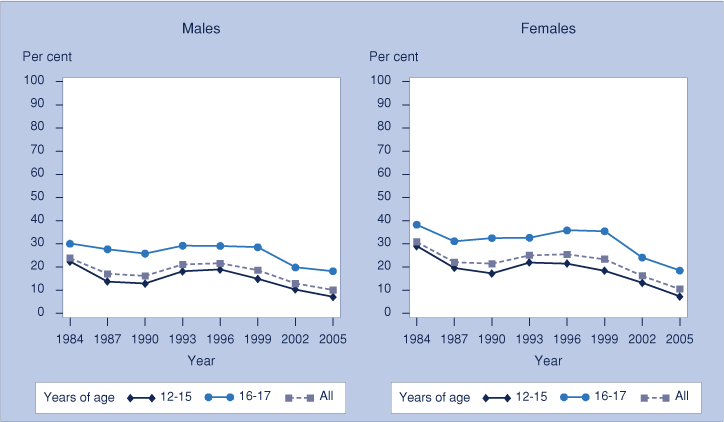Tobacco smoking among secondary school students in NSW
Michael Giffin A B and Margo Eyeson-Annan AA NSW Health Survey Program, Centre for Epidemiology and Research, NSW Department of Health
B Corresponding author. michael.giffin@doh.health.nsw.gov.au
NSW Public Health Bulletin 19(4) 75-76 https://doi.org/10.1071/NB08002
Published: 29 April 2008
In New South Wales (NSW), it is illegal to sell or supply tobacco to a person under 18 years of age. Most people who become long-term smokers start smoking in their teenage years. Early uptake is associated with heavier smoking and greater difficulty in quitting. Preventing adolescents from becoming regular users of tobacco is an important goal of tobacco control programs in Australia.1–4
In 2005, the New South Wales School Students Health Behaviours Survey asked students aged 12–17 years a range of questions about smoking prevention, behaviour, addiction and influences. This article describes results for selected questions. Further details on the survey methods, questions asked and complete results for smoking and other health behaviours can be obtained from the New South Wales School Students Health Behaviours Survey: 2005 Report at http://www.health.nsw.gov.au/publichealth/surveys/index.asp.5
Results
Smoking prevention
In 2005, among students aged 12–17 years, 92.4% had a lesson or part of a lesson about tobacco smoking. There was no significant difference between male and female students. Students aged 12–15 years (93.6%) were significantly more likely than students aged 16–17 years (89.1%) to have had a lesson or part of a lesson about tobacco smoking. There was no significant difference by socio-economic level, or between urban areas or rural areas; however, students living in the North Coast Area Health Service (96.4%) were significantly more likely to have had a lesson or part of a lesson about smoking, compared with the overall student population.
Smoking behaviour
In 2005, among students aged 12–17 years, 10.3% were current tobacco smokers. There was no significant difference between male and female students. Students aged 16–17 years (18.4%) were significantly more likely than students aged 12–15 years (7.3%) to be current tobacco smokers. There was no significant difference by level of socio-economic disadvantage, or between rural areas and urban areas; however, students in the Greater Southern Area Health Service (14.1%) were significantly more likely, and students in the Sydney South West Area Health Service (6.9%) were significantly less likely, to be current tobacco smokers, compared with the overall student population. As shown in Figure 1, there has been a significant decrease in the proportion of students who are current tobacco smokers, between 1984 (27.3%) and 2005 (10.3%).
Smoking addiction
In 2005, among students aged 12–17 years who were current tobacco smokers, 21.3% thought they were addicted to tobacco. There was no significant difference between males and females, by level of socio-economic disadvantage, or between rural areas and urban areas; however, students in the Greater Western Area Health Service were significantly more likely to think they were addicted to tobacco (58.6%), compared with the overall student population. There has been no significant change in the proportion of students who think they are addicted to tobacco between 2002 and 2005.
Smoking influences
In 2005, among students aged 12–17 years, 56.9% thought smoking by celebrities encouraged young people to take up smoking. There was no significant difference between males and females, between age groups, by level of socio-economic disadvantage, or between rural areas and urban areas; however, students in the Sydney South West Area Health Service (63.7%) were significantly more likely, and students in the Northern Sydney and Central Coast Area Health Service (50.8%) were significantly less likely, to think smoking by celebrities encourages young people to take up smoking.
The next New South Wales School Students Health Behaviours Survey is in 2008.
[1]
[2]
[3]
[4]
[5]


